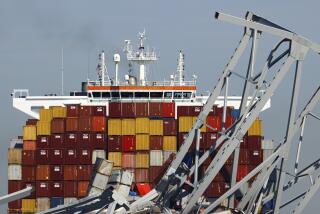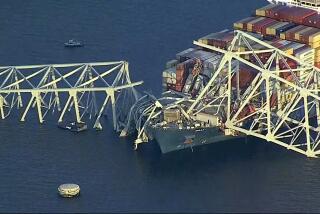Aquino Orders Investigation of Ferry Disaster
MANILA — As thousands of relatives waited to hear whether their loved ones had survived the sinking of a passenger ferry in this week’s typhoon, Philippine President Corazon Aquino on Wednesday ordered an investigation into the loss, which left hundreds of people dead or missing.
Transportation Secretary Reinerio Reyes said that if Sulpicio Lines, operators of the ferry Dona Marilyn, is found to be at fault, it will be stripped of its operating license.
Sulpicio Lines also owned the liner Dona Paz, which collided with an oil tanker and sank last year with the loss of more than 2,000 lives. Investigators found that the Dona Paz had been overloaded and that coast guard inspectors had been paid to ignore the violation. Several coast guard officers were suspended, but the company was not punished.
A spokesman for Sulpicio Lines, Vicente Go, said early today that rescuers had found 179 survivors of the Dona Marilyn who managed to swim to nearby islands or were rescued by fishermen after the ferry sank Monday in the Visayan Sea south of Manila at the peak of Typhoon Ruby.
As firsthand accounts from those survivors began reaching Manila on Wednesday night, it was clear that the Dona Marilyn, unlike the Dona Paz, was equipped with more than enough life jackets and lifeboats. But in the panic aboard the sinking ferry, many passengers leaped from the ship without them, while others took two or three life vests each.
“Everybody was jumping into the sea,” said a Sulpicio Lines official who had interviewed 10 of the survivors. “Some took the lifeboats, but there were so many people that they decided to jump and swim.”
Some of the survivors who washed up on two remote islands several hours later spoke of having hallucinations during the panic. Visibility was only a few feet in the lashing rain and 140-m.p.h. wind around the ship, but several survivors insisted that they saw an island nearby and decided to swim for it.
Swam for Hours
Most told reporters that they swam for more than three hours. Alberto Oledan, 29, said he swam and floated for 12 hours before rescuers found him. Oledan had jumped from the sinking ferry with his wife and two sons, but they apparently perished.
As rescuers finished searching the islands of Maripipi and Almagro, it was clear that there were more victims than survivors.
As of this morning, government officials reported that 32 bodies had been recovered near the site of the sinking. They said the fate of the remaining passengers, now estimated at more than 300, remained unknown.
At Manila’s North Harbor, from which the Dona Marilyn set out Sunday night bound for Tacloban on Leyte Island, relatives were besieging the Sulpicio offices for information.
The company had said that 451 passengers were listed on the ship’s manifest, but it was obvious Wednesday that there were many others on board whose names were not on the manifest. The government has identified several survivors whose names were not listed.
“I know my parents were on the Dona Marilyn, but their names are not on the list,” said a young woman who was keeping a vigil at the Sulpicio offices.
Every few hours, as company clerks read out new lists of the names of known survivors, waiting relatives would shout, “Thank you, dear God.”
But most sat quietly, determined to stay on until they get some word.
A dockhand, asking not to be quoted by name, observed: “It was like history repeating itself. The tears of the relatives of the victims of the Dona Paz have not yet dried, and here there is another one. Now the corpses will start arriving again, and people will start crying all over the place again.”
Aquino ordered the investigation after Sulpicio was condemned by a number of political figures, among them Sen. John Osmena, who said the firm’s license should be revoked immediately.
“Something is clearly wrong with the shipping company’s vessels,” Osmena said.
Rep. Antonio Cuenco, speaker pro tem of the House of Representatives, said Sulpicio should be held criminally liable for allowing the Dona Marilyn to sail despite a coast guard warning that Typhoon Ruby was approaching.
Meanwhile, much of the country was trying to recover from the effects of the storm, which devastated croplands, inundated villages and towns and left an estimated 100,000 people homeless.
Declares ‘State of Calamity’
Aquino announced a “state of national calamity” in six regions of the country, including metropolitan Manila.
Officials estimate that Typhoon Ruby, which roared through the central and northern Philippines on Monday and Tuesday ruined more than 300,000 acres of crops ready to be harvested.
Damage to roads, schools and bridges was estimated at more than $7 million, plus perhaps $100 million more in exports and other lost economic opportunities--a serious blow to Aquino’s economic recovery program.
Government health workers were placed on alert to deal with expected epidemics of diarrhea.
More to Read
Sign up for Essential California
The most important California stories and recommendations in your inbox every morning.
You may occasionally receive promotional content from the Los Angeles Times.










